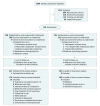Effect of Piperacillin-Tazobactam vs Meropenem on 30-Day Mortality for Patients With E coli or Klebsiella pneumoniae Bloodstream Infection and Ceftriaxone Resistance: A Randomized Clinical Trial
- PMID: 30208454
- PMCID: PMC6143100
- DOI: 10.1001/jama.2018.12163
Effect of Piperacillin-Tazobactam vs Meropenem on 30-Day Mortality for Patients With E coli or Klebsiella pneumoniae Bloodstream Infection and Ceftriaxone Resistance: A Randomized Clinical Trial
Erratum in
-
Missing Information on Sample Size.JAMA. 2019 Jun 18;321(23):2370. doi: 10.1001/jama.2019.6706. JAMA. 2019. PMID: 31211326 Free PMC article. No abstract available.
Abstract
Importance: Extended-spectrum β-lactamases mediate resistance to third-generation cephalosporins (eg, ceftriaxone) in Escherichia coli and Klebsiella pneumoniae. Significant infections caused by these strains are usually treated with carbapenems, potentially selecting for carbapenem resistance. Piperacillin-tazobactam may be an effective "carbapenem-sparing" option to treat extended-spectrum β-lactamase producers.
Objectives: To determine whether definitive therapy with piperacillin-tazobactam is noninferior to meropenem (a carbapenem) in patients with bloodstream infection caused by ceftriaxone-nonsusceptible E coli or K pneumoniae.
Design, setting, and participants: Noninferiority, parallel group, randomized clinical trial included hospitalized patients enrolled from 26 sites in 9 countries from February 2014 to July 2017. Adult patients were eligible if they had at least 1 positive blood culture with E coli or Klebsiella spp testing nonsusceptible to ceftriaxone but susceptible to piperacillin-tazobactam. Of 1646 patients screened, 391 were included in the study.
Interventions: Patients were randomly assigned 1:1 to intravenous piperacillin-tazobactam, 4.5 g, every 6 hours (n = 188 participants) or meropenem, 1 g, every 8 hours (n = 191 participants) for a minimum of 4 days, up to a maximum of 14 days, with the total duration determined by the treating clinician.
Main outcomes and measures: The primary outcome was all-cause mortality at 30 days after randomization. A noninferiority margin of 5% was used.
Results: Among 379 patients (mean age, 66.5 years; 47.8% women) who were randomized appropriately, received at least 1 dose of study drug, and were included in the primary analysis population, 378 (99.7%) completed the trial and were assessed for the primary outcome. A total of 23 of 187 patients (12.3%) randomized to piperacillin-tazobactam met the primary outcome of mortality at 30 days compared with 7 of 191 (3.7%) randomized to meropenem (risk difference, 8.6% [1-sided 97.5% CI, -∞ to 14.5%]; P = .90 for noninferiority). Effects were consistent in an analysis of the per-protocol population. Nonfatal serious adverse events occurred in 5 of 188 patients (2.7%) in the piperacillin-tazobactam group and 3 of 191 (1.6%) in the meropenem group.
Conclusions and relevance: Among patients with E coli or K pneumoniae bloodstream infection and ceftriaxone resistance, definitive treatment with piperacillin-tazobactam compared with meropenem did not result in a noninferior 30-day mortality. These findings do not support use of piperacillin-tazobactam in this setting.
Trial registration: anzctr.org.au Identifiers: ACTRN12613000532707 and ACTRN12615000403538 and ClinicalTrials.gov Identifier: NCT02176122.
Conflict of interest statement
Figures


Comment in
-
Carbapenem-Sparing Therapy for Extended-Spectrum β-Lactamase-Producing E coli and Klebsiella pneumoniae Bloodstream Infection: The Search Continues.JAMA. 2018 Sep 11;320(10):979-981. doi: 10.1001/jama.2018.12565. JAMA. 2018. PMID: 30208439 No abstract available.
-
Antibiotics for Ceftriaxone-Resistant Gram-Negative Bacterial Bloodstream Infections.JAMA. 2019 Feb 12;321(6):612-613. doi: 10.1001/jama.2018.19345. JAMA. 2019. PMID: 30747960 No abstract available.
-
Antibiotics for Ceftriaxone-Resistant Gram-Negative Bacterial Bloodstream Infections.JAMA. 2019 Feb 12;321(6):613. doi: 10.1001/jama.2018.19349. JAMA. 2019. PMID: 30747961 No abstract available.
References
-
- Centers for Disease Control and Prevention Antibiotic Resistance Threats in the United States. Washington, DC: US Department of Health and Human Services; 2013.
Publication types
MeSH terms
Substances
Associated data
LinkOut - more resources
Full Text Sources
Other Literature Sources
Medical
Miscellaneous

